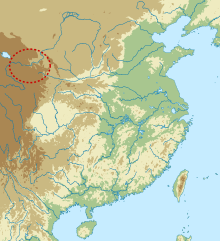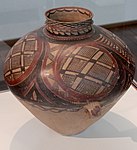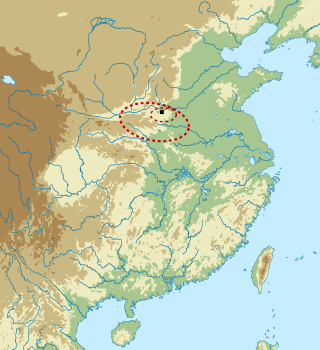The 5th millennium BC spanned the years 5000 BC to 4001 BC. It is impossible to precisely date events that happened around the time of this millennium and all dates mentioned here are estimates mostly based on geological and anthropological analysis.

The Yangshao culture was a Neolithic culture that existed extensively along the middle reaches of the Yellow River in China from around 5000 BC to 3000 BC. The culture is named after the Yangshao site, the first excavated site of this culture, which was discovered in 1921 in Yangshao town, Mianchi County, Sanmenxia, western Henan Province by the Swedish geologist Johan Gunnar Andersson (1874–1960). The culture flourished mainly in the provinces of Henan, Shaanxi and Shanxi.

The Longshanculture, also sometimes referred to as the Black Pottery Culture, was a late Neolithic culture in the middle and lower Yellow River valley areas of northern China from about 3000 to 1900 BC. The first archaeological find of this culture took place at the Chengziya Archaeological Site in 1928, with the first excavations in 1930 and 1931. The culture is named after the nearby modern town of Longshan in Zhangqiu, Shandong. The culture was noted for its highly polished black pottery. The population expanded dramatically during the 3rd millennium BC, with many settlements having rammed earth walls. It decreased in most areas around 2000 BC until the central area evolved into the Bronze Age Erlitou culture. The Longshan culture has been linked to the early Sinitic . According to the area and cultural type, the Longshan culture can be divided into two types: Shandong Longshan and Henan Longshan. Among them, Shandong Longshan Cultural Site includes Chengziya Site; Henan Longshan Cultural Site includes Dengfeng Wangchenggang Site in Wangwan, Taosi Site and Mengzhuang Site in Hougang.
The Hongshan culture was a Neolithic culture in the West Liao river basin in northeast China. Hongshan sites have been found in an area stretching from Inner Mongolia to Liaoning, and dated from about 4700 to 2900 BC.

The Dawenkou culture was a Chinese Neolithic culture primarily located in the eastern province of Shandong, but also appearing in Anhui, Henan and Jiangsu. The culture existed from 4300 to 2600 BC, and co-existed with the Yangshao culture. Turquoise, jade and ivory artefacts are commonly found at Dawenkou sites. The earliest examples of alligator drums appear at Dawenkou sites. Neolithic signs, perhaps related to subsequent scripts, such as those of the Shang dynasty, have been found on Dawenkou pottery.

The Hemudu culture was a Neolithic culture that flourished just south of the Hangzhou Bay in Jiangnan in modern Yuyao, Zhejiang, China. The culture may be divided into early and late phases, before and after 4000 BC respectively. The site at Hemudu, 22 km northwest of Ningbo, was discovered in 1973. Hemudu sites were also discovered at Tianluoshan in Yuyao city, and on the islands of Zhoushan. Hemudu are said to have differed physically from inhabitants of the Yellow River sites to the north. Some authors propose that the Hemudu Culture was a source of the pre-Austronesian cultures.

Banpo is an archaeological site discovered in 1953 by Shi Xingbang, and located in the Yellow River Valley just east of Xi'an, China. It contains the remains of several well organized Neolithic settlements, like Jiangzhai, carbon dated to 6700–5600 years ago. The area of 5 to 6 hectares is surrounded by a ditch, probably a defensive moat, 5 to 6 meters wide. The houses were circular, built of mud and wood with overhanging thatched roofs. They sat on low foundations. There appear to be communal burial areas.

The Qijia culture was an early Bronze Age culture distributed around the upper Yellow River region of Gansu and eastern Qinghai, China. It is regarded as one of the earliest bronze cultures in China.
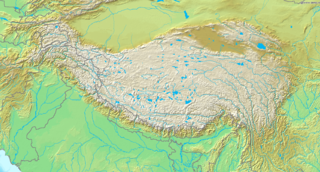
The Karuo culture was a Neolithic culture in Tibet. The culture cultivated foxtail millet.

The Dadiwan culture was a Neolithic culture located primarily in the eastern portion of Gansu and Shaanxi provinces in modern China. The culture takes its name from the deepest cultural layer found during the original excavation of the type site at Dadiwan. The remains of millet, pigs and dogs have been found in sites associated with the culture, which is itself defined by a thin-walled, cord-marked ceramic tradition sometimes referred to as Laoguantai. The Dadiwan culture shares a variety of common features, in pottery, architecture, and economy, with the Cishan and Peiligang cultures to the east.

Metallurgy in China has a long history, with the earliest metal objects in China dating back to around 3,000 BCE. The majority of early metal items found in China come from the North-Western Region. China was the earliest civilization to use the blast furnace and produce cast iron.
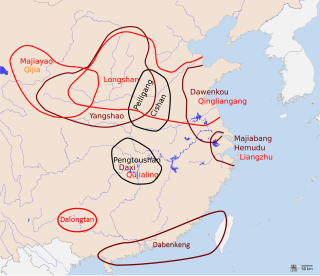
Banshan was a phase of the Chinese Neolithic Majiayao culture, c. 2600 to 2300 BC. The Banshan site is in Guanghe County, Gansu.

Jiangzhai is a Banpo phase Yangshao culture archaeological site in the east of Xi'an, where the earliest copper artifacts in China were found.

Xindian culture was a Bronze Age culture in the Gansu and Qinghai provinces of China. Xindian culture is dated ca. 1500–1000 BCE, a radiocarbon testing of an artefact produced a date around 1000 BCE, which roughly corresponds to the Western Zhou period of the Central Plain area.

The Siba culture, also called Huoshaogou culture (火烧沟), was a Bronze Age archaeological culture that flourished circa 1900 to 1500 BC in the Hexi Corridor, in Gansu Province of Northwest China. It was discovered in 1984 at Sibatan in Shandan County. Siba type pottery vessels are different from the others in Gansu. Siba produced painted pottery with coloured decorations; these were painted after the vessels had been fired. Similar pottery was used by the Tianshanbeilu culture at Hami basin to the west.

The Baijia culture (Ch:百家文化) is an ancient Neolithic culture of China, dated to 5800-5000 BCE. It is considered as the earliest Chinese culture to make painted pottery. The pottery was sometimes painted in simple red.

The Xichengyi culture (Ch:西城驿文化) was an ancient culture in the central Heihe River region of the Hexi corridor, from 2,000 to 1,600 BCE. It is contemporary with the Qijia culture to its southeast. It succeeded the Majiayao culture in the area, and preceded the Siba culture.
